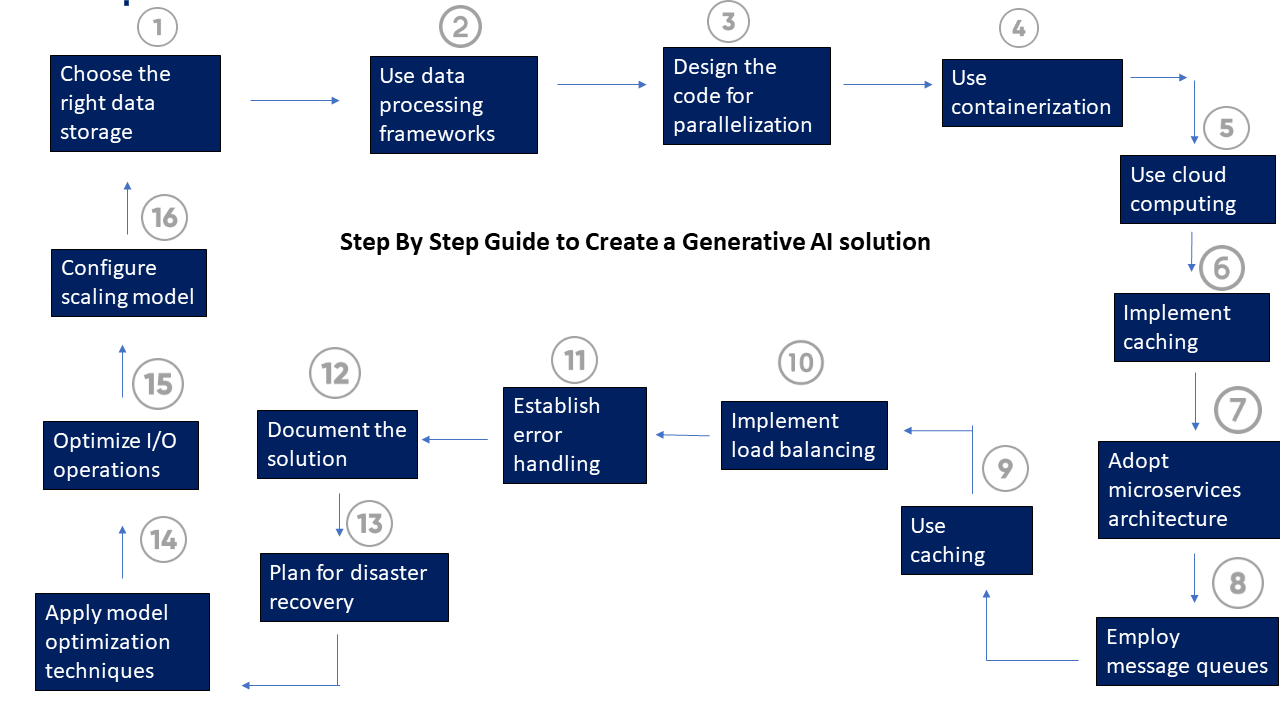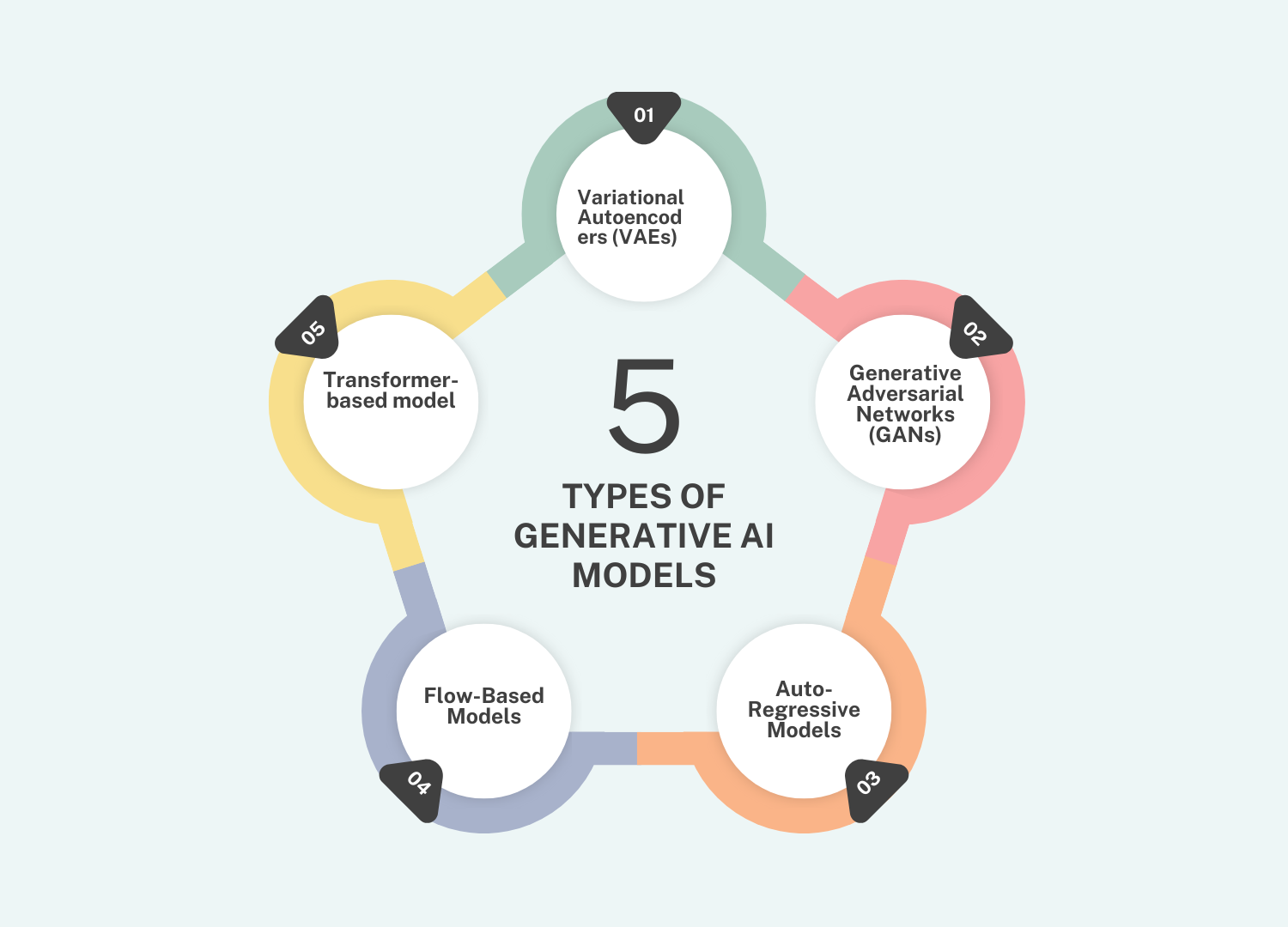Table of Contents
Since generative artificial intelligence (Gen AI) is almost everywhere, the intention to use the internet for information consumption has completely changed. This is due to consumers producing content from these solutions rather than using search engines to find it. As to the latest poll conducted by Salesforce regarding the usage of generative AI, 73% of Indians, 49% of Australians, and 45% of Americans utilize it.
A subset of artificial intelligence called generative AI development, or Gen AI, can create text, graphics, whole databases, and other types of material on its own. It uses a range of human input and learned data to generate the content. Applications for Gen AI range from text and image generating to the creation of chatbots that mimic human speech.
The use of Generative AI services is so widespread that the Salesforce study refers to its customers as “super-users” because of its potential to transform drug research and its availability for answers to any basic curiosity. It indicates that these consumers are getting the hang of Gen AI and often use its solutions.
An excellent business opportunity for entrepreneurs and startup owners looking to bootstrap their ventures is Generative AI services. Let’s first discuss what generative AI development is and some of its basic principles before you hire an AI developer to create a solution.
Elevate Your Projects With Generative AI Development
Evolution of Generative AI: Key Milestones and Breakthroughs
Generative AI development is being used for a greater variety of issues as they grow in strength and efficiency. A wide range of industries, including healthcare, banking, and entertainment, now use generative AI development services. Additionally, experts in head-ups are racing to further their education in generative AI.
According to Statista, the generative AI development industry is expected to grow at a rate of 24.40% per year (CAGR 2023–2030) and reach a value of US$207.00 billion by 2030. Generative AI development enables the creation of realistic images and videos for use in movies, TV shows, and video games. Healthcare practitioners can use this technology to create realistic medical images for diagnosis and treatment purposes. Most people today associate generative AI with either OpenAI, the company that developed DALL-E and ChatGPT, or with Microsoft and Alphabet. However, the timeframe of the technology spans organizations and decades. Several noteworthy turning points in the evolution of generative AI include:
1956 – The Dartmouth Workshop
One of the most important moments in history was the Dartmouth Workshop the birthplace of artificial intelligence. This two-month conference was the foundation of the artificial intelligence research led by Claude Shannon, Nathaniel Rochester, John McCarthy, and Marvin Minsky. Participants established the foundation for future advancements in the field by looking at topics including learning, language processing, and problem-solving.
1957 – Perceptron
One of the earliest artificial neural networks, the Perceptron, was invented by Frank Rosenblatt. This seminal research introduced the concept of perceptrons, which are single-layer neural networks with decision-making and learning capabilities. The Perceptron, despite its limited capabilities, proved to be a crucial element in subsequent neural network research.
1966 – ELIZA First Chatbot
One of the earliest chatbots was ELIZA created by Joseph Weizenbaum which copied human communication. While ELIZA was basic by today’s standards, it showed what natural language processing with generative AI could do. It showed that machines are capable of responding to discussions and conversations just like humans, and this caused a rising interest in the field of conversational AI.
1970s–1980s – Expert Systems Era
Expert systems became a well-known AI technique during this time. These computers mimicked human competence in particular topics by using rule-based reasoning. By accurately identifying infectious diseases, MYCIN, a Stanford University project, became a ground-breaking illustration of the promise of expert systems in the medical domain.
1997 – Garry Kasparov vs. Deep Blue
Everyone is familiar with the historic moment when Garry Kasparov the world chess champion played a game of chess with the IBM supercomputer Deep Blue, and guess what the supercomputer successfully defeated the world chess champion marking a significant milestone in the history of artificial intelligence. It showed that a machine could beat a person at a challenging game that calls for appraisal, strategy, and decision-making.
1997 – Introduction to Machine Learning
Machine learning is a scientific discipline that explores the construction and study of algorithms that can learn from data. With machine learning solutions emphasizing data-driven algorithms and the ability to facilitate the creation of AI systems that can adapt and enhance their performance over time, this concept signaled a change in the direction of AI research.
According to Tom M. Mitchell, “Machine learning is the study of computer algorithms that allow computer programs to automatically improve through experience”
2012 – Deep Learning and ImageNet
Deep learning showed what it could do with the ImageNet big test. By using CNNs, Geoffrey Hinton’s team got way better at spotting objects. This big win for deep learning in sorting pictures and dealing with loads of data kicked off a big rush in AI studies.
Eager to Know the Difference Between Machine Learning & Deep Learning?
2014 – GANs, or Generative Adversarial Networks
The generative AI development field underwent a revolutionary change with the introduction of GANs by Ian Goodfellow. AlphaGo, made by DeepMind, did something huge by beating Go champ Lee Sedol. This win proved AI could master a super hard game, one that needs deep thinking and plans. AlphaGo’s win showed AI could take on big human challenges.
2016 – AlphaGo
AlphaGo, developed by DeepMind, achieved an extraordinary feat by defeating world champion Go player Lee Sedol. This milestone marked the triumph of AI in a complex game with an enormous number of possible moves, requiring intuition and strategic thinking. AlphaGo’s success highlighted the potential of AI to tackle challenges that were previously considered uniquely human.
2017 – Natural Language Processing and Transformers
The way we make machines understand and speak language got a big boost from the Transformer model by Vaswani and team. Transformers look at words altogether to get the meaning better, push forward chat help, translate languages, figuring out feelings in text, and more.
How do Generative AI models work?
Algorithms are used in generative AI development to examine relationships and patterns in the available data. The entire basis of Generative AI’s operation lies in how thoroughly it has been trained on large-scale datasets. For instance, generative AI goes through a similar kind of training or reading process to that which we use to teach children how to identify an image of a person based on their visual or textual interpretation.
The capacity of generative AI models to use various learning strategies, such as supervised or unsupervised learning for training, is one of their main innovations. In the early days of generative AI, data submission required the use of an API or other laborious procedures. The developers needed to learn how to use specialized tools and write programs in languages like Python. These days, Top generative AI companies are creating improved user interfaces that enable you to express a request in simple terms. Following an initial response, you can further tailor the outcomes by providing input regarding the tone, style, and other aspects you would like the generated content to encompass.

Key Consideration for Developers to Build Generative AI Models
Developing a generative AI solution is a methodical process that this detailed guide will take you through in full. To create a successful generative AI system, each step is essential. Continue reading to start turning your generative AI development concept into a workable solution.
1. Identify the issue and goal
First things first: the process of developing a generative AI solution is determined by the problem statement or specification. The problems you wish to use creative generative AI to tackle, such as realistic visuals, style transfer, and more, are included in the problem definition or statement.
2. Prototyping
Building a streamlined version of your AI model allows you to test and evaluate its essential features. This process is known as prototyping. It helps stakeholders and entrepreneurs to see the potential of AI/ML solutions, recognize possible obstacles, and make necessary design revisions. Through prototyping, stakeholders may see the potential of the AI system, recognize any obstacles, and make necessary design iterations.
Gathering and Preparing Data
Thoroughly sourcing high-quality data—which may include text, photos, or other pertinent data types—that is ideally representative of the problem area is necessary for the collection process. The data goes through a thorough processing process when it is collected. To remove noise, mistakes, and inconsistencies, the dataset must be cleaned, formatted, and organized.
To guarantee that the model can generalize across a range of inputs, proper data normalization and standardization are essential. As they set the stage for later model training and assessment, data preparation and collecting in this context are essential processes that are critical to the development of successful generative AI/ML solutions.
Select the right generative AI algorithms
The machine learning algorithm or model you use for your Gen AI solution will determine the output’s accuracy and overall quality. Use the method that best fits the problem, whether it be a GAN, VAE, or another model. Take into account the format of your data—text, photos, or other—as well as the intended result to guarantee the efficacy of your AI model.
For example, GANs might be the best option if you want to produce realistic images, whereas RNNs, or recurrent neural networks, work better with sequential input, such as text. To meet the project’s needs, it is also crucial to evaluate the scalability of the selected method and the available computational resources.
Create, Develop, and Assess Your Generative AI Model
Once the method has been chosen, your generative AI development needs to be trained using curated or annotated datasets. Iterations are a part of the training process, where your model improves its performance over time by honing its skills.
Despite being self-supervised or semi-supervised, generative AI development services require human intervention to optimize the model’s performance and improve the output’s accuracy and precision. You may maximize the generative AI model’s potential and make sure it meets the goals of your project and produces the intended content by iterative training and assessing the model.
3. Development
Establish a development environment first, including the hardware, software, libraries, tools, and other resources needed for the developers to create, test, and implement generative AI development models. It’s time to code after your development environment is set up. One of the most important phases in creating a generative artificial intelligence (Gen AI) solution is development, which requires skilled AI solution providers for hire to take on several important tasks to produce a strong and efficient generative AI solution.
4. Validation and Testing
You can use QA testers at this stage to carry out exacting processes to verify that the generative AI service provider corresponds with the desired goals. A/B testing, user, functional, performance, unit, and other types of testing are all included in testing. Additionally, validation checks verify that the solution satisfies predefined standards for accuracy and quality. An Artificial intelligence development company can optimize the performance of generative AI systems and minimize associated risks by following different testing and validation requirements.
5. Deployment
The goal of this phase is to move the AI model from a controlled development environment to an actual use case. Important deployment needs include making sure the hardware infrastructure is scalable to handle changing workloads and choosing the right hardware to satisfy the computing demands of generative AI development.
It also entails integration with current systems, extensive testing (approval testing), and ongoing monitoring for mistake identification and performance enhancement. To protect sensitive data during deployment, carefully consider the security precautions and adherence to data protection laws.
6. Maintenance and Improvements
Improvements are essential to gradually increase the AI system’s capabilities and efficiency. Regular inspections, upgrades, and troubleshooting are all part of maintenance, which makes sure the AI system keeps up with the most recent developments and runs without a hitch.
This stage involves adjusting algorithms, streamlining data processing, and adding user input to maintain the solution current with changing requirements and technological capabilities.
Experience Next Generation GenAI With Us
Ethical and Legal Aspects of Generative AI Development
Even while generating original text, graphics, and music can be quite appealing, we always need to be mindful of the moral issues involved. The following lists several potential dangers and mitigating techniques along with the important ethics in AI that organizations experimenting with generative AI development must follow.
Deepfakes and Misinformation
It is concerning because generative AI can create information that conflates fact and fiction. These works, which range from edited films to fake news stories, have the power to sway public opinion, support misinformation, and hurt people and organizations.
Any artificial intelligence solutions company discovered to have participated, directly or indirectly, in the dissemination of false information faces a steep price in the shape of a damaged reputation. In addition to a damaged reputation, consider a situation in which a stock price collapses overnight due to a deep fake video that allegedly captures a CEO making contentious remarks. Earned trust is difficult to maintain.
Bias And Discrimination
The data provided to generative models is reflected in them. As such, they will unintentionally reinforce biases if trained on biased datasets. Ethics in AI that unintentionally reinforces or even magnifies societal biases may face backlash from the public, legal implications, and harm to its reputation. Consider facial recognition software which can incorrectly identify people due to bias. It can also result in legal disputes or disastrous PR situations.
Put diversity in training datasets first, and commit to regular audits to look for biases that weren’t intended. Diverse training data is emphasized by organizations such as OpenAI. Businesses can form alliances with these groups, guaranteeing that their generative models go through stringent external audits and bias checks.
Intellectual Property And Copyright
There are serious legal issues when generative AI creates stuff that looks exactly like already-published copyrighted materials. Infringements of intellectual property may lead to expensive legal disputes and harm to one’s reputation. Think about the music business, where a generative AI’s musical composition that sounds a lot like a copyrighted song by an artist could result in pricey legal action and negative public reaction.
Make sure the training materials are licensed and provide a clear explanation of the production process for created content. Transparent accountability can be ensured by tracking the origins of training content through the use of metadata tagging. Jukin Media, for instance, provides a platform for obtaining permissions and rights for content created by users. Adopting such ethical practices can protect against inadvertent violations.
Data Security And Privacy
There are privacy hazards associated with generative models, especially those trained on personal data. AI in security is a serious concern, especially concerning data being misused or being used to create artificial profiles that are uncannily accurate.
A violation of user privacy or improper use of data may result in legal repercussions and damage user confidence. An AI trained on individual medical histories can unintentionally create a synthetic profile that resembles a genuine patient, raising privacy issues and perhaps violating the Health Insurance Portability and Accountability Act (HIPAA).
When training models, lean on the side of anonymization and support data security protocols to guarantee that user data is safe. For instance, the data minimization principle of the GDPR states that only data that is required should be processed. Similar guidelines should be followed by businesses, who should make sure that all non-essential personal data is deleted before training and AI in security when storing data.
Responsibility
The attribution of responsibility is more difficult because of the complex pipeline in the construction and deployment of generative AI. An unclear accountability framework can lead to finger-pointing, complicated legal situations, and diminished brand credibility in the event of an incident. Think back to the previous disputes with AI chatbots that were displaying offensive or hateful messages. Brand damage results from an intensified blame game in the absence of unambiguous accountability.
Create clear guidelines outlining the appropriate application of generative AI. Businesses can utilize policies similar to X’s (formerly known as Twitter) guidelines for synthetic and modified media as a model. These guidelines clearly define and set boundaries for the usage and distribution of such information. In addition, feedback loops—which allow users to report dubious outputs—can be quite helpful.

Future of generative AI development: Upcoming trends for Developers
Working with AI expedites the development process for seasoned engineers who are skilled at writing sophisticated code. Writing a lot of boilerplate code is a common task, and our developer community frequently demands the use of AI for test case generation. Generative AI development can be really helpful in this area. AI can generate test cases from scratch, saving developers time and enabling them to concentrate on customizing the scenarios for their business. Machine learning companies may build critical code for their users.
Second, by making app creation more accessible to a wider audience, working with AI copilots democratizes the process. It can assist new users in getting going, complete knowledge gaps, and even clarify ideas and procedures. AI functions as a supercharged assistant, offering direction and support while learning new technologies, like creating an Apex callout.
Last but not least, generative AI development offers a chance to raise the standard of code being written and the dependability of developers’ work. This is only the start because AI has unrealized potential for improving code stability, scalability, performance optimization, and issue identification.
The role that low-code developers play in allowing AI behaviors is interesting. Determining where to incorporate AI capabilities and what the copilot should be able to do becomes essential when deploying AI in an enterprise setting. Those who write low-code are frequently administrators or business users with a deeper understanding of the demands of the company. Because of their proximity, they can work with business stakeholders to comprehend their needs and tailor AI solutions to meet those demands.
Quantum Artificial Intelligence
Using the principles of quantum mechanics, quantum artificial intelligence represents a significant step forward from classical computers. Working with quantum bits (qubits), which are different from traditional bits, quantum artificial intelligence (AI) takes advantage of the unusual property that allows it to exist in several states at once, resulting in exponential increases in processing capacity. This feature enables quantum AI to process and analyze large, complex datasets at previously unheard-of speeds.
Multimodal AI Models
Prominent advancements in multimodal Gen AI LLM have the potential to completely transform creative capacities. Llama 2, Mistral, and GPT-4 are three significant language models that serve as examples of this progression. Popular LLMs such as GPT-4V and future models like LLava, which embrace many data formats, are also intended to make artificial intelligence more dynamic and user-friendly.
Small Language Models
In the future of AI, it’s anticipated that small language models (SLMs), which are trained on carefully selected, excellent datasets, will be commonplace compared to their larger counterparts. Large language models (LLMs), and small language models (SLMs) such as Microsoft’s PHI-2 and Mistral 7B can perform better at handling smaller jobs since they have fewer parameters and lower system needs.
Self-governing Agents in Generative AI
The future of AI is radically changing due to the use of multimodal AI and sophisticated algorithms by artificial intelligence companies. By utilizing state-of-the-art instruments like LangChain and LlamaIndex, these self-governing systems demonstrate the ability to learn from a variety of datasets and draw well-informed conclusions.
The advent of generative AI development with sophisticated emotional intelligence is one of the most anticipated technologies.
Generative AI in Different Domains
- AI systems can enhance empathy and personalization in mental health, education, and customer service. It can do so by interpreting and responding to human emotions
- The incorporation of generative AI tools into quantum computing is another novel field. By combining these two technologies, artificial intelligence (AI) systems may become considerably more powerful and efficient, opening up new avenues for complicated problem-solving, scientific study, and possibly even space travel.
- The use of generative AI tools has the potential to completely transform software development by improving data collecting and client-analyst comprehension in interactions. This innovation allows for quick prototyping, which reduces the dangers related to misunderstandings.
- Furthermore, generative AI model development increases developer productivity and improves software quality by automating the creation of code snippets in many languages.
Go on an Innovative Adventure Into AI and Discover The Unparalleled Power of Intelligent Solutions
Conclusion
The remarkable complexity and user-friendliness of ChatGPT models encouraged generative AI development to become widely used. Undoubtedly, the rapid uptake of generative AI applications has also highlighted certain challenges in implementing this technology responsibly and safely. However, research into more advanced instruments for identifying text, photos, and video generated by AI has been spurred by these early implementation problems.
Indeed, a lot of training programs catering to various skill levels have been made possible by the growing popularity of generative AI technologies like ChatGPT, Midjourney, Stable Diffusion, and Bard. The goal of many is to assist developers in creating AI applications. Others concentrate more on business users who want to implement the new technology throughout the company.
Yet there are obstacles in the way of this adventure. Businesses need to come up with strategic solutions to deal with the challenges that generative AI presents. For example, testing use cases and making sure the company has the operational framework, data infrastructure, technological know-how, and risk management needed for success. To overcome these obstacles, ensuring adherence to regulations, robust security measures, and resource-intensive training will be essential.
Experience the power of Developing AI solutions by Partnering with A3Logics
The field of generative AI development will keep evolving, leading to breakthroughs in translation, medication discovery, anomaly detection, and the creation of original writing, film, music, and fashion design. Even if these new standalone tools are excellent, the real impact of generative AI will come from the integration of these capabilities into our everyday tools in the future.
For example, grammar checks will improve. Design tools will allow us to easily incorporate more beneficial suggestions into our workflows. To train other employees more effectively, training systems will be able to automatically recognize excellent practices in one area of a business. These are only a few examples of how generative AI development will soon alter our daily activities.
When it comes to leveraging AI for your company, A3Logics, a leading artificial intelligence solution provider is your go-to partner. We are experts in creating superior, personalized AI solutions that cater to your particular requirements. Custom AI solutions, NLP solutions, wearable software with AI capabilities, and smooth AI integration are among the specializations of our talented team of AI developers. We bring a plethora of knowledge to the table along with a proven track record of innovation and performance. Because of our experience and dedication to quality, we are the partner of choice for maximizing the potential of AI technology.
FAQ
How is AI beneficial for businesses?
In a nutshell, artificial intelligence service streamlines corporate operations, enabling improved productivity and more effective procedures. AI can give information that can help in making smarter decisions. Finally, this enterprise-level information made available to small business owners can help them plan for labor, inventory, and funding.
How long does it take to develop a Generative AI model?
The amount of time it takes might vary greatly depending on the intricacy of the problem, the amount and caliber of the dataset, and the user’s level of experience. Simple models may be built in a few days, while more complex problems might take weeks or even months to solve.
How much does it cost to develop a generative AI system?
The complexity of the project, the quantity of data required, the infrastructure, the location and experience level of the team, the engagement model, and other variables all affect how much it costs to construct a generative AI system. Basic apps with few features may cost less, whereas more complicated applications with extensive features may cost more. A basic Generative AI program may cost between $40,000 and $100,000. A more feature-rich application may cost anywhere from $100,000 to $400,000 or more
What is the difference between generative AI and artificial generational intelligence (AGI)?
Artificial generational intelligence, or AGI, is capable of comprehension, learning, and performing a wide range of tasks at or above the human level. It is capable of similar cognitive functions as humans. Generative AI is a subset of AI that focuses on producing data or content. It frequently does this by generating text, graphics, or other media using methods like neural networks. All in all, AGI seeks to mimic human intellect, whereas generative AI is a more focused application of AI as a whole.
What advantages does generative AI offer?
Businesses may provide their clients with extremely tailored experiences thanks to generative AI. It drives recommendation engines, which make product recommendations based on user preferences. Sales and customer satisfaction rise as a result. It also influences the creation of voice assistants that improve user interaction.
What dangers might generative AI pose?
A misuse of generative AI could result in the creation of false information or deepfake videos, which could mislead and hurt people as well as society. This is one of the hazards of generative AI. Additionally, creating realistic-looking faces or other sensitive data carries the risk of privacy infringement. However, biases in the training data can get unintentionally strengthened by AI algorithms, causing discrimination in the generated material.
What is generative AI exactly, and why is it becoming so popular?
With the help of generative AI, users may produce new content rapidly with a range of inputs. These models can accept text, photos, music, animation, 3D models, and other kinds of data as inputs and outputs. Numerous opportunities arise from this capability, ranging from helping with drug discovery and tailored medicine to automating content creation.






